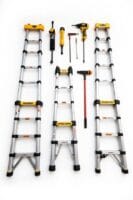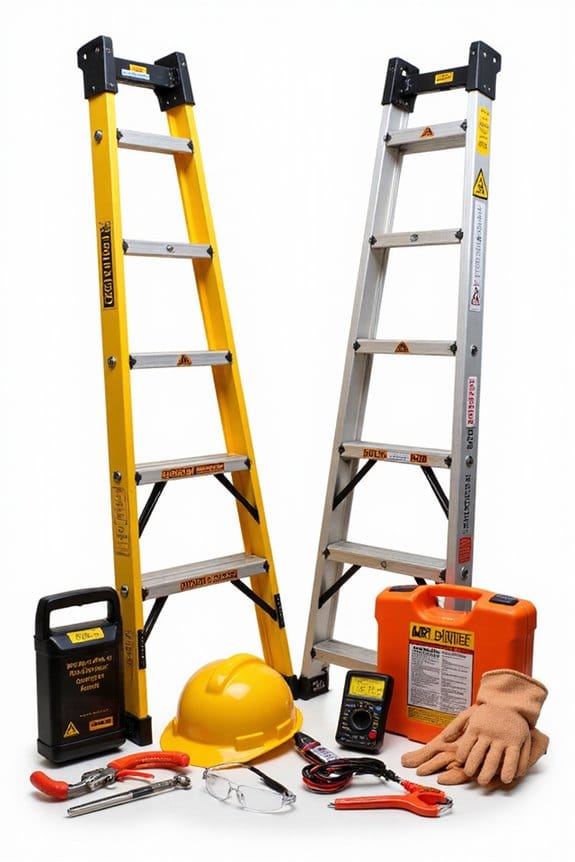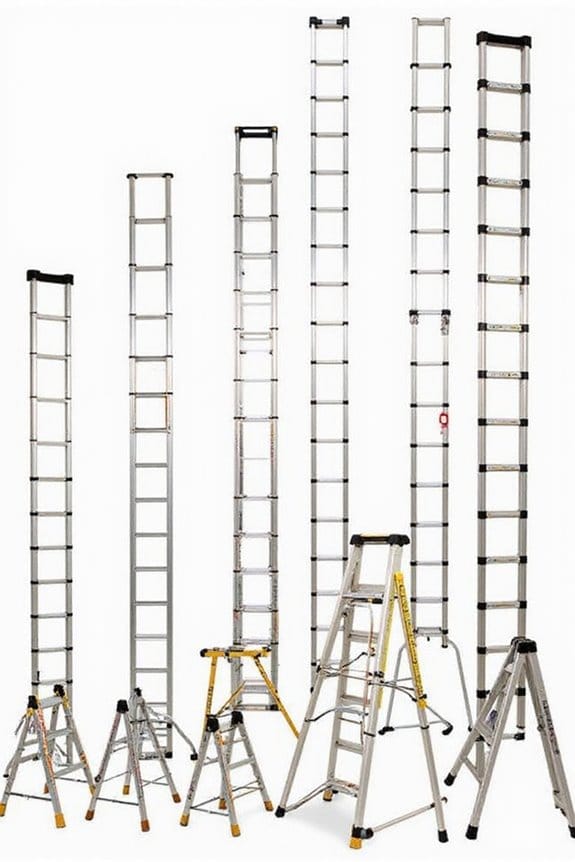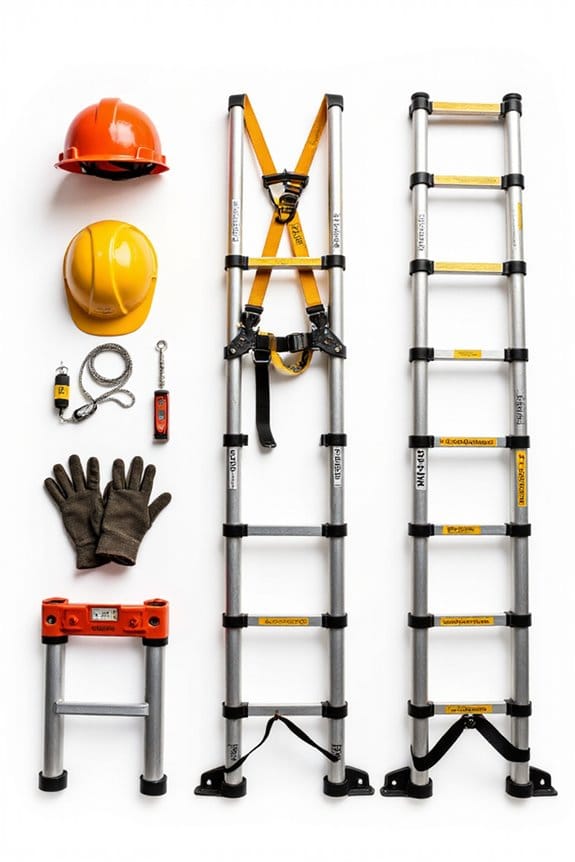To inspect a ladder for defects, I recommend following these steps: 1) Check materials; aluminum’s lightweight but can bend, while fiberglass is stronger. 2) Inspect structural components like rails and rungs for cracks or looseness. 3) Verify the surface is clean—dirt can be slippery! 4) Look for safety features like non-slip feet and handrails. 5) Store it properly in a dry, clean space. Trust me; these checks can save you from a mishap later on! Keep exploring for more tips.
Key Takeaways
- Inspect the ladder for visible cracks, bends, or rust on rails to ensure structural integrity and stability.
- Check all rungs for cracks or looseness, as secure rungs are essential for safe climbing.
- Verify that all hardware, including bolts and screws, is tight and secure to prevent accidents during use.
- Ensure the feet and non-slip pads are in good condition to maintain stability and prevent slips.
- Clean the ladder regularly to remove dirt or grease, ensuring it remains safe and functional.
General Ladder Characteristics to Inspect

When it comes to ladder safety, checking the general characteristics is like giving your trusty ladder a health checkup. Here’s how I do it:
- Ladder Materials: Make certain you know what your ladder’s made of. Aluminum and fiberglass have different strengths and weaknesses.
- Inspection Frequency: I recommend inspecting your ladder before every use. It only takes a minute!
- Rungs and Rails: Check for cracks, looseness, or any slippery substances. You don’t want a surprise slip!
- Hardware: Inspect bolts and screws; they should be tight and secure.
- Cleanliness: Verify no dirt or grease is lurking around. A clean ladder is a happy ladder! Additionally, ensure that the ladder has safety features like anti-slip steps and locking mechanisms for enhanced security during use.
Keep these tips in mind, and your ladder will keep you safe!
Structural Components Inspection

Inspecting the structural components of your ladder is vital—after all, it’s what keeps you safe while you’re up there! Here’s how I tackle it:
- Rails: Look for cracks, bends, or rust. Straight rails guarantee rail stability, which is essential for safety. If they’re warped or twisted, it’s time to retire that ladder.
- Rungs: Check for cracks or looseness. Rung security is key; if they wobble, you might be in for a surprise!
- Braces: Inspect for any breaks or damage. They hold everything together, so don’t skip this step.
- Feet: Make sure they’re in good condition. Wobbly feet? Not a good look! Ensuring non-slip foot pads are intact can significantly enhance your safety during use.
Regular inspections can save you from a nasty fall. Stay safe out there!
Surface Condition and Cleanliness
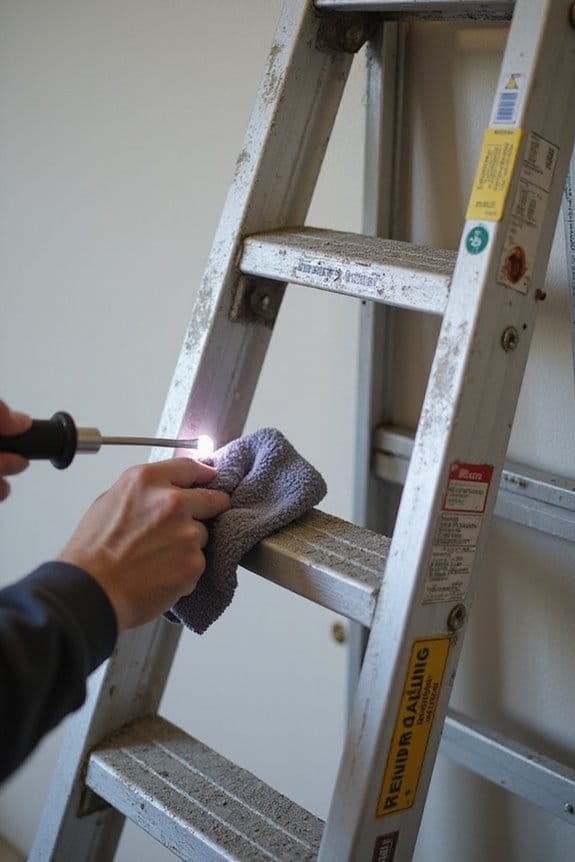
While guaranteeing your ladder’s structural components are in good shape is a big part of safety, the surface condition and cleanliness are equally important. Here’s what I check during my cleanliness inspection:
- Look for surface damage: Check for cracks, splits, or rust, especially on metal ladders. Don’t ignore the feet and pads; they’re essential for grip.
- Keep it clean: Remove dirt, grease, or any debris that could cause slips. I always make certain rungs are free from paint or chemical residues.
- Examine anti-slip features: Verify non-skid surfaces are intact. Worn materials can be a slippery disaster waiting to happen!
Ladder Safety Features and Accessories
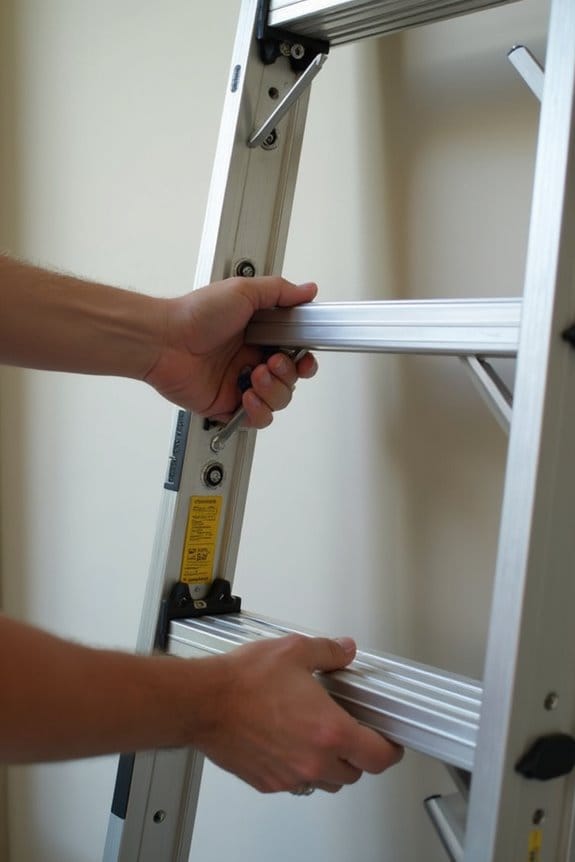
Ladders come with a variety of safety features and accessories that make climbing safer and more efficient. Here are some must-haves:
- Safety Devices: Ladder levelers and stabilizers enhance stability, especially on uneven surfaces. Trust me, they make a difference!
- Climbing Assists: Some ladders include climbing assist devices, making it easier to reach those high spots without feeling like you’re scaling Everest.
- Non-Slip Feet: Look for ladders with non-slip feet. They’re essential for preventing those awkward slips when you least expect it.
- Handrails: If you’re using a taller ladder, handrails provide that extra support we all need sometimes.
- Ladder Stand-offs: These keep your ladder away from walls, giving you more space to maneuver.
With these features, you can climb confidently! Additionally, multi-position ladders are versatile tools that can adapt to various tasks, enhancing their usability and safety.
Proper Ladder Storage and Maintenance
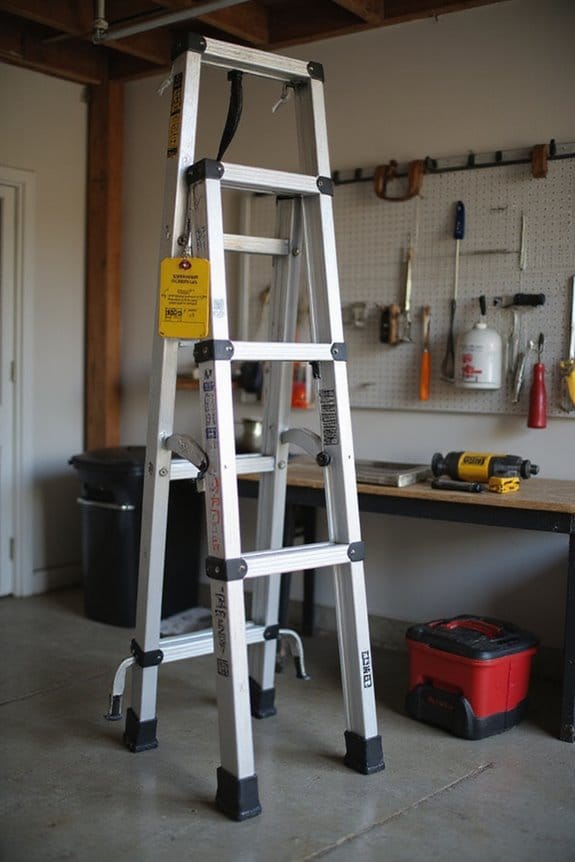
After you’ve equipped yourself with ladders that feature all those nifty safety accessories, it’s time to think about how to store and maintain them properly. Here are some tips:
- Clean and Dry: Store ladders in a clean, dry place away from direct sunlight and heat sources.
- Physical Storage: Use racks or hooks for horizontal storage. This prevents warping and damage.
- Regular Inspections: Make it a habit to check for cracks or loose parts during your maintenance routines.
- Protective Measures: Use padded supports and cover contact points to minimize wear and tear.
- Labeling: Organize your storage space. It saves time and prevents accidents.
Taking these steps will keep your ladders safe and extend their lifespan. Trust me, it’s worth it!
Frequently Asked Questions
How Often Should Ladders Be Inspected for Safety?
I believe ladder inspection frequency is essential for safety. I check mine before each use and recommend regular ladder maintenance, especially after any incident or in harsh conditions, to guarantee they remain safe and reliable.
What Is the Proper Way to Store a Ladder?
When I think about ladder storage, I always make certain it’s clean, dry, and protected from sunlight. Proper ladder maintenance keeps it safe and functional, so I regularly check for damage before storing it securely.
Can I Use a Ladder With Minor Defects?
Picture a rickety ladder swaying beneath me; it’s not worth the risk. I always assess for defects before climbing. Ladder safety comes first—minor defects can lead to accidents. Better safe than sorry, right?
What Should I Do if I Find a Defect?
If I find a defect, I stop using the ladder immediately. I’d document the defect for reporting, flag it, and explore repair options with qualified personnel to guarantee safety and compliance with standards.
Are There Specific Regulations for Ladder Inspections?
When it comes to ladder safety, I can assure you there are specific inspection guidelines to follow. Regulations vary by state, but regular checks for defects are essential to keep everyone safe and sound.


